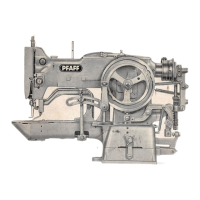19.
Adjusting
the
Lengthwise
Clamp
Travel
the
feed lengthwise
motion
is derived
from
the control slot on the back of feed cam
W {Fig. 17). Motion is
transmitted
from
the
roller
on
stud
P2 to
feed
regulator
V.
hinge
block
J (Fig. 14),
feed
regulator
post
K,
feed
plate
carrier
b
and
the
work
clamp.
To
adjust
the
lengthwise
clamp
travel,
move
hinge
block
J
downward
as
far
as
It will
go.
Turn
the
driving
pulley
by
hand
and
check
whether
the
needle
hole
remains
within
the
clamp
feet
slot
when
these
feet
reach
the
extreme
positons
of
their
lengthwise
travel.
If
the
machine
makes
a
bar-type
seam,
also
check
whether
the
plain
stitches
In
the
de
sign
are
correctly
centered
over
the
long
stitches.
To
check
this,
place
a
piece
of stiff
paper
under
the
clamp
and
examine
the
stitch
pattern.
For
a
precise
adjustment
of
the
feed
lengthwise
motion
loosen
the
nut
on
stud
P2
(Fig.
17)
and
move
the
stud
in
the
elongated
hole
of
feed
regulator
V,
as
required.
Then
tighten
the
nut
securely.
-01
•••Vx
• .
Fig.
17
20.
Timing
the
Feed
Cam
The
feed cam is located on the right hand
side
of the machine arm (as
seen
from the
operator). It controls both the feed lengthwise and
the
feed
across
motions. The feeding
motion
begins
after the
needle
has
risen
clear
of the fabric and
ends
before the
needle
penetrates
the material again. If the feeding begins too early or
ends
too late, the feed
ing motion is retimed by turning the cam on its shaft.
To
do
this,
loosen
nut
Y (Fig. 18)
and
stud
X
and
turn
the
feed
cam
on
the
transverse
shaft
(the
cam
can
be
turned
within
the
limits
set
by
stud
X riding in
the
elongated
hole
in
cam
positioning block 2). After
the
adjustment,
tighten
stud
X
and
nut Y
securely.
R
5793
r
W'
fell
Yt®fX
Fig.
18

